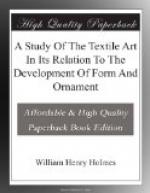Turning to other branches of art, what traces do we find of the transfer to them of textile features? Take, for example, sculpture. In the wood carving of the Polynesians we observe a most elaborate system of decoration, more or less geometric in character. We do not need to look a second time to discover a striking likeness to the textile system, and we ask, Is it also derived from a textile source? In the first place let us seek within the art a reason for the peculiar forms. In carving wood and in tracing figures upon it with pointed tools the tendency would certainly be towards straight lines and formal combinations; but in this work there would be a lack of uniformity in execution and of persistency in narrow lines of combination, such as result from the constant necessity of counting and spacing in the textile art. In the presentation of natural forms curved lines are called for, and there is nothing inherent in the carver’s art to forbid the turning of such lines with the graver or knife. Graphic art would be realistic to an extent regulated by the skill and habits of the artist. But, in reality, the geometric character of this work is very pronounced, and we turn naturally toward the textile art to ask whether in some way that art has not exercised an influence. The textile arts of these peoples are highly developed and were doubtless so in a degree from very early times, and must have had a close relation with the various arts, and especially so in the matter of ornament. Specific examples may be cited showing the intimacy of wood carving to textilia. Bows, spears, arrows, &c. are bound with textile materials to increase their strength. Knives and other weapons are covered with textile sheaths and handles of certain utensils are lashed on with twisted cords. In ceremonial objects these textile features are elaborated for ornament and the characteristic features of this ornament are transferred to associated surfaces of wood and stone by the graver. A most instructive illustration is seen in the ceremonial adzes so numerous in museums (Fig. 356). The cords used primarily in attaching the haft are, after loss of function, elaborately plaited and interwoven until they become an important feature and assume the character of decoration. The heavy wooden handles are elaborately carved, and the suggestions of figures given by the interlaced cords are carried out in such detail that at a little distance it is impossible to say where the real textile surface ceases and the sculptured portion begins.
All things considered, I regard it as highly probable that much of the geometric character exhibited in Polynesian decoration is due to textile dominance. That these peoples are in the habit of employing textile designs in non-textile arts is shown in articles of costume, such as the tapa cloths, made from the bark of the mulberry tree, which are painted or stamped in elaborate geometric patterns. This transfer is also a perfectly natural one, as the ornament is applied to articles having functions identical with the woven stuffs in which the patterns originate, and, besides, the transfer is accomplished by means of stamps themselves textile. Fig. 357 illustrates the construction of these stamps and indicates just how the textile character is acquired.




